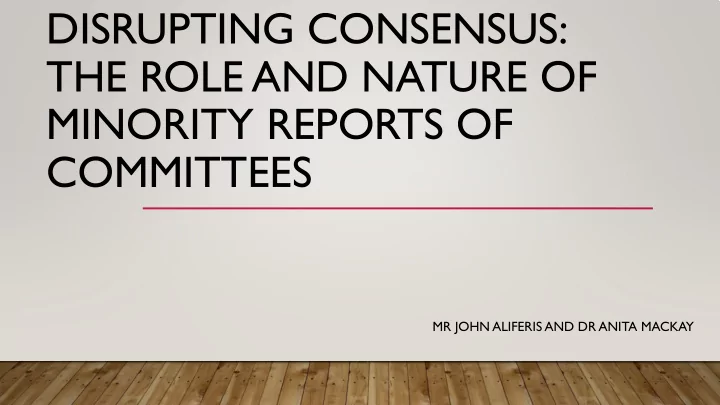

DISRUPTING CONSENSUS: THE ROLE AND NATURE OF MINORITY REPORTS OF COMMITTEES MR JOHN ALIFERIS AND DR ANITA MACKAY
OVERVIEW 1. Minority Reports as institutionalised dissent 2. Nuanced dissent: A taxonomy for classifying minority reports (developed based on reports of Victorian Joint Investigatory Committees) Illustrations of 4 types of Minority Reports from Victoria 3. Minority Reports as a barometer of health in a democratic system?
INSTITUTIONALISED DISSENT – AN INTRODUCTION • Joint Parliamentary committees deal with contested inquiry areas on behalf of the whole of Parliament • The party in government usually controls the membership of committees, therefore there is the spectre of bias towards government-friendly findings • Ways to address this bias are set out in legislation, standing orders/custom
MINORITY REPORTS AND DISSENT • Minority reports are one of two paths to deal with conflict – representing a unique form institutionalised dissent • A Committee minority (single member or a group of members) can write their own ‘report’ on the Inquiry topic. • MR deal with any matter raised during the Inquiry and can, and usually do, include alternate findings and recommendations.
WHY DO MINORITY REPORTS MATTER? • Consensus norm in committees Unanimous committee reports seen as preferred • Minority reports seen as a sign of Committee/parliamentary disfunction Particularly among overseas and commonwealth researchers • Our research finds that dissent in the form of minority reports is nuanced, positive and plays an important role • But MR motivation is important • Political motives are more closely aligned with ideas of dysfunction
WHY DO MINORITY REPORTS MATTER? • Minority reports represent broad parliamentary and democratic principles at play • Plurality: Providing a means to capture multiple views/voices (insiders and outsiders) • Normative influence (generating reaction from government or from civil society) • Canary and sentinel function: deal with gerrymander and committee abuses of power
MINORITY REPORTS IN ACTION THE VICTORIAN EXPERIENCE • Minority Reports a stable, and very consistent element of Victorian Joint Committees • Consistency over time, different political parties in power and government/non-government control of committees • Dissent captured in MR almost always focused on ‘real’/’valid’ motivations (evidence/policy debate/abuse of process/power) • Analysis shows they are almost never used as an extension of House tactics –political attacks
MINORITY REPORTS IN ACTION THE VICTORIAN EXPERIENCE 2006-18 Victorian Minority Reports by Minority Reports by taxonomy 2006-18 Parliamentary term 2006-2018 12 Political 50 10 Total reports Evidence 40 8 Malpractice Minority 30 reports 6 Policy 20 4 10 2 0 0 2006-10 2010-14 2014-2018 2006-10 2010-14 2014-2018
Image: "HMS Beagle in the Galapagos" by John Chancellor. TAXONOMY 4 CATEGORIES OF MINORITY REPORTS IDENTIFIERS • Policy (most common) • Objective/purpose • Malpractice/malfeasance • Structure • Evidence • Language • Political (least common) • Evidentiary basis (reliance and use of evidence) Classification makes appropriate responses to different categories of reports conceivable
• Highlights several recommendations in the main POLICY: report that the minority do not support; detailed ALTERNATIVE DISPUTE reasons RESOLUTION AND • Uses quotes from experts as supporting RESTORATIVE JUSTICE (LAW REFORM CTTEE) (2009) evidence • Report is structured formally; with headings • Language is rational and dispassionate E.g. “it is premature to reach that conclusion on the basis of the evidence available to date” Colourful marine iguana
• Raises concerns about Committee processes, including that no public hearings were held, submissions were not made public and an MALPRACTICE / MALFEASANCE: ARRANGEMENTS FOR important report was not made available to the SECURITY INFORMATION Committee (LAW REFORM CTTEE) (2010) • Report is structured formally; headings; logical flow • Language is critical and conspiratorial E.g. “the consequent gagging of the minority members of this Committee is unprecedented” Yellow land iguana
EVIDENCE: • Short report, focusing on perceived lack of APPROACHES TO attention on one issue HOMEWORK IN VICTORIAN • Refers to evidence of a student that the minority SCHOOLS (EDUCATION & TRAINING CTTEE) (2014) considers was overlooked in the main report • Report is informal and short (2 pages) • Language is accusatorial and conspiratorial E.g. “the Government has removed the very financial assistance that is designed to help” Grey marine iguana
• Objective of the report is to criticise the POLITICAL: position taken by the Labor Party during the PROVISIONS OF THE inquiry ELECTORAL ACT 2002 RELATING TO POLITICAL • It is a short report (1.5 pages) that quotes ADVERTISING (ELECTORAL submissions and extracts from transcripts of MATTERS CTTEE) (2010) public hearings • The language used is antagonistic and critical E.g. “the position adopted by the ALP could be categorised as … in the words of Les Tentyman ‘a debasement of the political system’” Christmas iguana
MINORITY REPORTS AS A MEASURE OF PARLIAMENTARY HEALTH 1. Parliamentary politics domestically and internationally are seen by some to be ‘dysfunctional’ Minority Reports could be an extension of the ‘dysfunction’ 2. We suggest minority reports are a good measure/barometer of parliamentary and political health Consistent trend in numbers and types between parliamentary terms/change in government, a proxy for good health Statistically significant changes in types or numbers may indicate dysfunction (not just more minority reports but also fewer) 3. Tracking minority reports should be seen as a way of measuring the health of a parliamentary democracy
Recommend
More recommend